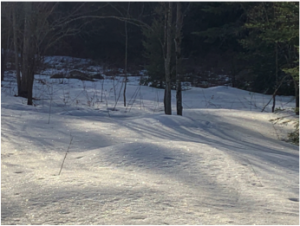Contributed by Laura Ruth
The Wisdom Jesus asks us to gently question the Christianity of tradition, and turn towards the discovery of what it means right here and now to seek and find the Wisdom Jesus in our lives. To live the path and connect with the person who was called the Single One, Ihidaya, Master. We are being pointed to a path, an unfolding process. The Gospel of Thomas logion quoted on the first page indicates that to seek includes becoming troubled and confused before opening to wonder, sovereignty and rest. And this is all ok. It is real.
It is a path that relies on what Cynthia calls, “our own power of inner recognition” (pg. 3): an inner capacity that can perceive “through a raw immediacy of presence” within which we are able to connect with our “own direct knowingness…Out of this sovereignty is born—our own inner authority” (pg. 7).
“Recognition energy…is the capacity to ground truth a spiritual experience in our own being” (pg. 80).
And this recognition energy is connected to wonder. Cynthia quotes Bruno Barnhart:
“Time after Time we feel the break-through of life, the wave-front of wonder” (pg. 8-9).
Grounded in our own direct experience and sense of wonder the path begins to reveal itself. Opening Wisdom Jesus to Chapter Six, we are met with a threshold question: “But how do (we) make this shift in consciousness?” Chapter Seven concludes with the question, are we willing or not to tolerate the “unmanageable simplicity” (as per Bruno Barnhart, pg. 75) of what Cynthia calls “being present to your life in love?” (pg 88).
Yes, how do we do this? Stay simple and present. To life. In love.
Doing is the definition of praxis, the root of the word. It is embodiment, practice, and the body of that practice that grows within us—in this case, toward the capacity to bear this unmanageable simplicity, and to stay present to our lives in love. Kenosis, self-emptying in love, is a descent down, towards and through that grows with practice.
I first heard Cynthia’s vision of the Trinity when she spoke about flying into Boston over tall windmills turning on the hills, each blade pouring into the next in a great circular dance, fluid, generative, a continual motion. The windmill and the waterwheel.
Cynthia speaks about the root of the word “person” in the Trinity—as the state or substance of being that is underlying each form taken: what stands inside and underneath. The foundation. The dynamic movement of the three persons in the Trinity turning and spilling, one to the other in a continuous giving is the dance. “God is love” and through the dance “love becomes manifest as the unified field of all reality” (pg.72).
How to wake to this love pouring not only through creation but into creation, creating and recreating creation in a constant turn and flow. This is part of us, a reality within us, and an invitation to turn with the wheel of a life lived lovingly—not through anything that we push, intend or hold onto—but through the act of letting go. Letting it slip through our fingers, with love.
The image of standing in the breach comes up; stepping into life in relationship with one’s whole self. Can we humble ourselves to take one small step towards the beloved, unattached to either what we do or what the outcome? To simply give, without looking for an equivalent exchange? To wake up and honestly, simply, be with what is? I make a choice this morning to go first to the brook, because it is changing, because it calls me, because it nourishes me, because I have been not well. It is tending to what is necessary right now. It is what will give me a leg to stand on today, that I may give more in other ways. Kenotic love is not a stepping back in detachment, or a letting go that floats away from it all. It is so deeply an outpouring into, so radical an act of self-giving and self-disclosure, that it cannot help but manifest. We do not have to make something happen. We simply let go and be, letting that which is within us flow. Breathe and follow the gesture, opening, toward.
If we participate with our whole hearts in the raw beingness of the moment, something new comes into being. Because it is real it is a creative moment—to meet life without succumbing to fear and doubt. Rather than repress, we can practice. Breathe and notice what is truly here. Gently relax our bodies around fear. Release our swirling emotions to the stiller pond below. Sink beneath the endless voices in the head, thank them for their warnings, feel them ease. Our minds work so hard to protect us here, assure us of where we are, who we are and where we stand in it all. It takes practice and awareness, to re-train our habitual responses to include a greater love.
Kenosis is about taking an unmeasured step in and giving ourselves fully. Jesus asked his people, can you just stay awake one more hour? Be witness here, to this moment? Mary Magdalene was practiced, she knew how. This self-emptying in love is neither about giving ourselves away or not caring. It is about staying with, with presence, living with the question. It discerns the subtle line of going forth and turning toward without clinging to a process or having an attachment to outcome. It is awake. It is the pause of listening, of true discernment. We find we are breathed.
Isn’t it remarkable that there is something within that can risk, can trust, that knows how to give fully in love without holding on to identity or losing our center, even for a second. This is what I love about this work. There are moments in our lives, when perhaps we recognize this. Small moments of dying to self. Step by step on the path. Peeling towards our un-identified core, that which perhaps has made a silent agreement with God; who knows? Glimpses caught, that we are indeed each a single ray of the whole. Moments of sensing we belong in an unbounded, unfathomable spectrum, whole in itself.
There is a substance that stands under that ray as our foundation, in the sense Cynthia names as hypostasis: the sediment in the original Greek—O blessed material world of ours! body of us! substance of earth! substance of light! Can we experience ourselves standing—part of earth, part of spirit? Can we touch it as sensation radiating through us, tingling and warm? With our attention we may open to the larger Presence—our underlying reality—feel it alive, in relationship: as the persons in the Trinity stand and move, states of being pouring one into the other, manifesting love.
We tread here on the edges of our known world—where the binary takes shape as either and or, where polarities appear irreconcilable. Jesus as tantric master seeks the unitive through kenosis (pg. 78). As human beings we are born to reconcile, but in large part we have forgotten how. Most of us have been busy doing other things. In practice, we breathe, and let go again, soften the boundaries of our postulations, re-ground in and open the heart. Experience how it is that we can both let go and turn toward—stay present to—in one beautiful act of love.
Chapter Twelve is Centering Prayer Meditation. Through it we ground in our bodies what it means to practice and live kenosis, to actually meet each moment with an inner gesture akin to self-emptying. The chapter opens with this beautiful Byzantine hymn, long forgotten:
Serene light shining in the ground of my being,
draw me to yourself.
Draw me past the snare of the senses,
out of the mazes of the mind.
Free me from symbols, from words,
that I may discover the signified:
the word unspoken in the darkness
that veils the ground of my being.
How beautifully Centering Prayer dovetails with kenotic praxis! Working the muscle of the heart through releasing anything clung to, even in the subtlest grasp. Centering Prayer is a way, in Cynthia’s words, of “patterning into our being that continuously repeated gesture of ‘let go, let go, let go’ at the core of the path that Jesus himself walked” (pg. 142). When I was first introduced to Centering Prayer I spent a long long time with Father Keating’s words, “I consent to the presence and action of God.” Drawn to the relational dynamism of self-emptying, I found it both an agreement and an embodiment:
Hineni Hineni
I’m ready my Lord.(Here I am, Here I am,
I’m ready my Lord.)
~Leonard Cohen, You Want it Darker, chorus
The body remembers through the rhythms we practice, the heart perceives by pattern and resonates with the Greater Heart. Self-emptying becomes pattern with practice; and equanimity begins to take the place of reactivity. Freedom from judgement allows for glimpses of the whole of a thing to emerge and be witnessed, and letting go of identities releases certain boundaries of perception. Perspective becomes available from different angles and from the ground of being in the heart rather than from a score of fixed notions and assumptions. New potentialities shine forth in interaction, come alive in relationship with all things animate and inanimate, manifest in something surprising and new coming into being. Remind us that yes, each moment is indeed a point which has never before come into being, and we are participants in the creative act of living life.
Cynthia reminds us just how close letting go is to letting be: and that it was “through God’s original ‘Let there be…’ that our visible worlds tumbled into existence.” (pg. 68). Wow. The letting go in the brook this morning, in your life today, in mine, is boundaryless. We can track it to the first and the last, and, as offering to the whole, take the next small step. We can keep descending, as Jesus did, relinquishing that which comforts us in our identities, bit by bit, for a deeper solace.
This humanness that we are, it is beautiful and terrible. My prayer is that my wounds, my transgressions, can be offered to the alchemical pot, humble gifts to the gods. My sense is that, just as a cut will heal, we humans do what we can do to heal. Walking between my will and thy will, forgetting and clinging, noticing, letting go. We pause—or we do not—and the moment passes. We rest and wake to life, to what this day brings. Ten thousand opportunities to be.
Ring the bells that still can ring
Forget your perfect offering
There is a crack in everything
That’s how the light gets in.
~Leonard Cohen, Anthem
Resource offered by Laura Ruth.
Won’t you join us? Please note that the Book Circle is now full. We encourage individuals and groups of all kinds to take up this study, and follow along with these monthly postings through June 2021, and would love to hear your reflections about this post and the book in the comments below. Thank you!
All of the images above were taken this morning, March 23 2021, on the Martin’s Brook path by Laura Ruth.
Wisdom Jesus Book Circle
A monthly series of resources from the friends and leaders of the Wisdom Waypoints Book Circle Series on: The Wisdom Jesus: Transforming Heart and Mind—A New Perspective on Christ and His message by Cynthia Bourgeault.





I see us as present in our life in love by abiding in and living from awareness that all creation is one, expressed with compassion in word and deed toward and with all creation. The word person means to sound through, to sound you through. For me that means that when what sounds through outwardly is in union with what is inwardly, you’ve got you together, you’re in love. Living such is right action, which is our responsibility and is reward in itself. I think focus on right action, not outcome, is critically important.
I love The Wisdom Jesus – writings that I come back to again and again. It has been a source of great encouragement and hope and a guide on my journey while so many of my Christian traditions and evangelical beliefs were falling away.